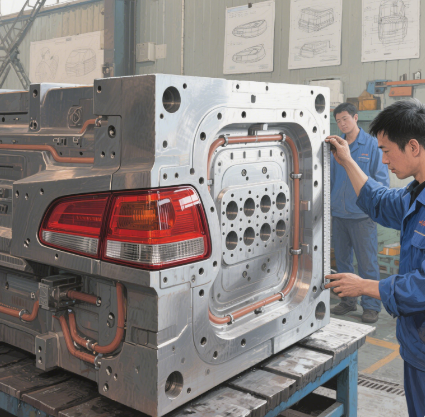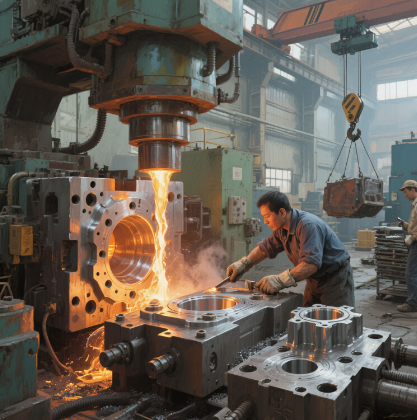In manufacturing and industrial design, the terms mold and cast are often used interchangeably, leading to confusion. While both are integral to producing precise components and products, they serve distinct purposes in the production process. Understanding the differences between molds and casts is essential for professionals in engineering, manufacturing, and design, as it impacts material selection, cost, and production efficiency. This article explores the definitions, key differences, and common applications of molds and casts, providing clarity for those navigating these critical processes.
A mold is a hollowed-out tool or template used to shape a material into a specific form. Typically made from durable materials like metal, plastic, or ceramic, molds are designed to withstand repeated use while maintaining precision. The mold acts as a negative or inverse shape of the desired product, allowing liquid or semi-liquid materials—such as molten metal, plastic, or resin—to be poured or injected into it. Once the material cools or cures, it takes on the mold’s shape and is removed, resulting in a finished or semi-finished product.
Molds are highly customizable and can be engineered to produce intricate designs with tight tolerances. They are used in various manufacturing processes, including injection molding, blow molding, and die casting. The quality of a mold directly affects the final product’s accuracy, surface finish, and structural integrity, making mold design a critical aspect of production.

A cast, on the other hand, refers to the final product created by pouring or injecting material into a mold. The casting process involves filling the mold’s cavity with a liquid or molten material, which then solidifies to form the cast. The cast is the physical object that emerges from the mold, embodying the shape and details defined by the mold’s design.
Casting is a versatile manufacturing technique used to produce everything from small, intricate components to large industrial parts. Common casting methods include sand casting, investment casting, and permanent mold casting, each suited to different materials and applications. The cast’s quality depends on factors like the mold’s precision, the material used, and the casting process’s control.
While molds and casts are closely related, they differ in purpose, construction, and application. Below, we explore the key distinctions under three critical aspects: usage in manufacturing, materials used, and cost and durability.
In manufacturing, molds are tools that facilitate the production of casts. Molds are reusable and designed for high-volume production in processes like injection molding or die casting. For example, in plastic injection molding, a mold is filled with molten plastic under high pressure, producing identical casts with each cycle. Molds are integral to automated, high-speed production lines, where consistency and efficiency are paramount.
Casts, by contrast, are the end products of these processes. Once a cast is removed from the mold, it may require additional finishing, such as trimming or polishing, but it represents the final or near-final component. In some cases, such as sand casting, the mold is destroyed after a single use, making the cast the primary output of the process. The choice of molding and casting techniques depends on the production scale, complexity, and desired material properties.
Molds are typically made from robust materials capable of withstanding high temperatures, pressures, and repeated use. Common mold materials include:
Steel: Used for high-precision, high-volume molds due to its durability and resistance to wear.
Aluminum: Lightweight and cost-effective, ideal for prototyping or lower-volume production.
Ceramics: Employed in specialized applications like investment casting, where heat resistance is critical.
Silicone: Flexible and used for low-volume or intricate designs, such as in resin casting.
Casts, however, are made from a wide range of materials, depending on the application. These include:
Metals: Aluminum, steel, or bronze for industrial parts or sculptures.
Plastics: ABS, polycarbonate, or nylon for consumer goods and automotive components.
Resins: Epoxy or polyurethane for artistic or prototyping purposes.
Concrete: Used in construction for precast elements like beams or panels.
The material choice for casts is driven by the product’s intended use, while mold materials are selected based on the casting process and production demands.
Molds are generally more expensive to produce than casts due to their precision engineering and durable materials. For instance, a steel mold for injection molding can cost thousands of dollars, reflecting the complexity of its design and the need for longevity. However, molds are built for durability, often lasting for thousands or even millions of cycles in high-volume production. Their cost is amortized over the number of casts produced, making them cost-effective for large-scale manufacturing.
Casts, being the final products, vary widely in cost depending on the material and complexity. A single cast produced via sand casting may be relatively inexpensive, especially if the mold is disposable. However, casts made from exotic materials or requiring intricate details can be costly. In terms of durability, casts are designed for their specific application—some, like metal engine parts, are highly durable, while others, like plastic prototypes, may be less so.
The trade-off between mold and cast costs is a key consideration in manufacturing. High initial mold costs are justified for large production runs, while low-cost, disposable molds may be preferred for one-off or small-batch casts.
| Aspect | Mold | Cast |
| Definition | A hollow tool or template used to shape materials into a specific form. | The final product created by pouring or injecting material into a mold. |
| Usage in Manufacturing | Reusable tool in processes like injection molding, die casting, or blow molding for high-volume production. | End product of the casting process, may require finishing; produced in methods like sand casting or investment casting. |
| Materials Used | Durable materials like steel, aluminum, ceramics, or silicone, chosen for longevity and process compatibility. | Wide range of materials including metals (e.g., aluminum, steel), plastics (e.g., ABS, nylon), resins, or concrete, based on application. |
| Cost | High initial cost due to precision engineering; cost-effective over large production runs. | Varies by material and complexity; generally lower cost per unit, especially in disposable mold processes. |
| Durability | Built for repeated use, lasting thousands to millions of cycles in high-volume settings. | Durability depends on material and use; ranges from robust (e.g., metal parts) to less durable (e.g., plastic prototypes). |
| Role in Process | Shapes the material by providing a negative cavity for the cast. | The solidified material that takes the shape of the mold’s cavity. |
| Examples | Steel mold for plastic injection, silicone mold for resin casting. | Plastic toy, metal engine block, concrete beam, resin figurine. |
Molds and casts are ubiquitous across industries, enabling the production of diverse products with precision and efficiency. Below are some of the most common applications, highlighting their versatility and importance.
In industries like automotive and aerospace, molds and casts are critical for producing complex components. Injection molding is widely used to create plastic parts, such as dashboards or gear knobs, with molds ensuring uniformity across thousands of units. Die casting, another common technique, produces metal parts like engine blocks or transmission housings, where molds withstand high temperatures and pressures to create robust casts.
Sand casting, often used for large metal components, relies on disposable molds made from sand and a binder. This method is ideal for producing heavy machinery parts or one-off industrial components. The casts from these processes are often subjected to rigorous testing to ensure they meet performance standards.

Molds and casts play a significant role in the production of everyday consumer products. Plastic toys, kitchenware, and electronic housings are typically made using injection molding, where molds enable high-speed production of identical casts. Blow molding, used for hollow objects like bottles and containers, relies on molds to shape molten plastic into lightweight, durable casts.
In the food industry, molds are used to shape chocolates, candies, and baked goods, with silicone or metal molds ensuring consistent shapes and textures. The casts—edible in this case—are the final products enjoyed by consumers.
In artistic applications, molds and casts enable the creation of sculptures, jewelry, and decorative objects. Investment casting, also known as lost-wax casting, is popular for producing detailed metal sculptures or fine jewelry. Here, a wax model is encased in a ceramic mold, which is then melted away, leaving a cavity for the molten metal cast.
Resin casting is another artistic technique, where flexible silicone molds are used to create intricate resin casts for models, figurines, or prototypes. Artists value the ability to produce multiple casts from a single mold, allowing for limited-edition runs or iterative design improvements.
In construction, molds and casts are used to create precast concrete elements, such as beams, columns, and decorative panels. Molds, often made from steel or fiberglass, ensure that each cast meets structural and aesthetic requirements. Precast concrete casts are produced off-site and transported to construction sites, improving efficiency and reducing on-site labor.
Architectural molds are also used for ornamental features, like cornices or balustrades, where casts replicate intricate designs with precision. The durability of molds ensures that multiple identical casts can be produced for large-scale projects.
In the medical field, molds and casts are used to create prosthetics, dental restorations, and medical devices. Silicone molds are often employed to produce custom casts for dental crowns or orthodontic appliances, ensuring a precise fit for patients. In prosthetics, molds are used to shape materials like carbon fiber or resin into lightweight, durable casts tailored to individual needs.
The precision of molds in these applications is critical, as even minor deviations can affect functionality or patient comfort. Casts in medical applications are typically single-use or custom-made, contrasting with the high-volume production seen in industrial settings.